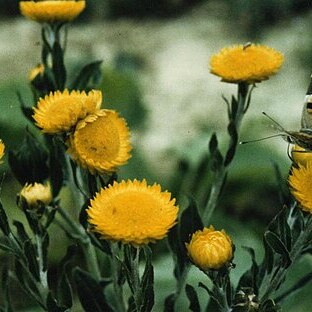Herbaceous perennial or subshrub, branched from the base, stock with vegetative buds or small leaf tufts, stems up to 1 m tall, but often only ±500 mm, woody, brittle, glandular-setose, uppermost parts sometimes white-cobwebby as well, closely leafy. Leaves mostly 20-50 x 10-20 mm, slightly smaller on the inflorescence branches, mostly oblong-ovate often becoming elliptic-lanceolate to lanceolate on the inflorescence branches, obtuse to acute, mucronate, base broad, more or less cordate-clasping, both surfaces and margins glandular-setose, margins and sometimes the midline above sometimes woolly as well, young leaves sometimes cobwebby all over. Heads heterogamous, 10-12(-14) mm long, about double that across the radiating bracts, depressed-globose, solitary at the tips of long leafy branchlets corymbosely arranged. Involucral bracts in ±9 series, graded, imbricate, inner much exceeding the flowers, glossy, yellow often overlaid pale brown outside. Receptacle shortly honeycombed or nearly smooth. Flowers ±480-1100, 65-160 female, 400-950 homogamous. Achenes 1 mm long, glabrous. Pappus bristles many, equalling the corolla, tips barbellate, shaft scabrid, base with patent cilia cohering or not.
Perennial herb or dwarf shrub, up to 1 m high; stems woody, branched from base, glandular-setose, upper parts sometimes white-cobwebby, closely leafy. Leaves: blade oblong-ovate, becoming elliptic-ovate to narrowly ovate on inflorescence branches, 20-50 x 10-20 mm, smaller upwards, apex obtuse to acute, mucronate, base broad, ± cordate clasping; both surfaces and margins glandular-setose, margins and midline above sometimes woolly. Heads disciform, 10-12(-14) x ± 25 mm, depressed-globose, solitary at tips of long, leafy branchlets, corymbosely arranged. Involucral bracts in ± 9 series, graded, imbricate, inner much exceeding florets, glossy, yellow, often overlaid pale brown outside; radiating, stereome divided. Receptacle epaleate, shortly honeycombed or nearly smooth. Flowers: female and disc florets 480-1100, 65-160 female; corolla of disc florets cylindric, yellow; Jan.-Apr. Fruit with cypsela glabrous. Pappus of many barbellate bristles, base with patent cilia, cohering or not.
Perennial herb or shrub, up to 1 m high. Leaves 20-50 x 10-20 mm, smaller upwards, oblong-ovate, becoming elliptic-lanceolate to lanceolate on inflorescence branches; both surfaces and margins glandular-setose, margins and midline above sometimes woolly. Heads 10-12(-14) mm long, depressed-globose, solitary at tips of long leafy branchlets corymbosely arranged. Flowers with yellow involucral bracts.

